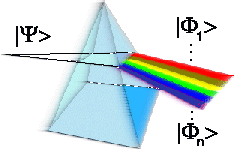Władysław Żakowicz and Maciej Janowicz
Spontaneous emission of photons by an atom placed near a dielectric cylindrical waveguide at an arbitrary position is analyzed using global free electromagnetic modes, satisfying necessary continuity conditions at the slab boundaries. These modes include the modes extended over the whole space (travelling) and the modes trapped to a waveguide (waveguided). To describe angular properties of the spontaneous emission, a parametrization of the travelling modes by the outgoing waves has been proposed. Angular characteristics of the travelling photon emission, distributions of the trapped photon emission, as well as the global decay rates have been calculated using the quantum approach and the standard perturbation theory. Difficulties due to the presence of sharp resonances (whispering gallery modes) among the travelling photons are pointed out.
Phys. Rev. A 62, 013820 (2000)
Jan 14, 2000
Interaction of a hydrogen atom with an intense pulse of vacuum ultraviolet radiation
J. Phys. B 33, 1271 (2000)
Mariusz Gajda, Jacek Krzywinski, Lukasz Plucinski and Bernard Piraux
The free electron laser (FEL) which is currently under construction at the DESY laboratory should deliver a photon beam in the vacuum ultraviolet (VUV) range. Coherent radiation of the FEL will soon allow for testing of the matter-electromagnetic field interaction under very exotic conditions. In this paper we study the ionization of a hydrogen atom by the intense (about 1016 W cm-2 ) beam of photons with energies of 17 eV. We compare exact numerical results with predictions of the perturbation theory showing the limits of its applicability and discussing requirements for the FEL pulse parameters which are necessary for observation of non-perturbative phenomena.
Mariusz Gajda, Jacek Krzywinski, Lukasz Plucinski and Bernard Piraux
The free electron laser (FEL) which is currently under construction at the DESY laboratory should deliver a photon beam in the vacuum ultraviolet (VUV) range. Coherent radiation of the FEL will soon allow for testing of the matter-electromagnetic field interaction under very exotic conditions. In this paper we study the ionization of a hydrogen atom by the intense (about 1016 W cm-2 ) beam of photons with energies of 17 eV. We compare exact numerical results with predictions of the perturbation theory showing the limits of its applicability and discussing requirements for the FEL pulse parameters which are necessary for observation of non-perturbative phenomena.
Subscribe to:
Comments (Atom)
